So why am I revisiting the topic now?
The short answer is it’s Joshua Palmatier’s fault.
Maybe I should give you the long answer.
Back in the early spring — it feels like a hundred years ago now — I wrote a pair of Writing-Tip Wednesday posts about dialogue and dialogue attribution. The post about attribution was particularly involved and long, and, to my mind, was one of the best writing advice posts I wrote this whole year.
So why am I revisiting the topic now?
The short answer is it’s Joshua Palmatier’s fault.
Maybe I should give you the long answer.
I have just finished writing my short story for the DERELICT anthology, the collection of stories Joshua and I are co-editing for his imprint, Zombies Need Brains. That’s right: I’m editing the anthology (as David B. Coe) and writing a story for it as an anchor author (as D.B. Jackson). The story is set in my Thieftaker universe and it’s titled (for now) “The Wreck of the Sarah Mohr.”
Writing for an anthology I’m also editing is something I’ve done with the other anthologies I’ve edited for ZNB, and each year Joshua has been pleased with my stories, except with regard to my dialogue attribution. He doesn’t like dialogue tags — “he said,” “she asked,” etc. I mean, he really doesn’t like them. And so every year, he goes through my stories and marks a bunch of them that he’d like me to cut.
Fine.
But not this year. This year, with this story, I was determined to preempt his edits. As I said in my post back in April, I am not one of those writers/editors who feels that all writing tags ought to be cut. I believe good dialogue attribution demands a mix of simple attribution, use of mannerism, gesture, and description to indicate who is speaking, and a few lines of straight dialogue with no tags. (I do suggest you go back and read that attribution post from the spring.) But for this story, I tried to use as few tags as possible.
And I found that imposing this limitation improved my storytelling. I really hate it when Joshua is right, so this is hard for me to admit. But it’s the truth. In trying to avoid the use of direct dialogue tags, I had to find other ways to keep clear in my readers’ minds who is speaking at any given time. In part that meant finding different ways to describe what my characters are doing or feeling. That, though, can carry risks. Too much description of that sort can sound clunky, and overuse of character mannerisms can make them seem twitchy.
So, the other thing I did was trust my dialogue more. In effect, I allowed my characters to speak for themselves, and I trusted my reader to be able to follow the course of their interactions. Now, when I say I trusted my reader, I am quoting an old editor of mine who used to say that whenever he thought I was explaining too much. “Trust your reader to understand,” he would scrawl in the margin. And what he really meant was, “Trust yourself. You’ve done the work. You’ve introduced your characters and established your narrative. Trust in that work and stop slowing down to explain stuff.”
“Trust your reader” equals “Trust yourself.”
So with this story, I trusted myself.
Here is a quick sample from the story:
Kannice sat in the chair adjacent to his. “I didn’t expect to see you here so early.”
“I had a good day.”
Her eyes fell to his jaw, which, no doubt, had already begun to darken. Ethan meant to heal himself before entering the tavern.
“Why do all your good days consist of beatings at the hands of Sephira Pryce’s ruffians?”
He grinned, winced. The skin around the bruise felt tight and tender. “In fairness, not all of them do. You and I have passed some very pleasant days without laying eyes on Sephira or her toughs. Or anyone else, for that matter.”
A reluctant smile crept over her features. “You found the gems you were seeking.”
“Aye, and was paid handsomely for their return.”
“And now you have a bit of coin to spend on me?”
“On you, on my rent, on the excellent chowders served here at the Dowsing Rod.”
“Well, I’d like a bit more spent on me.” She pulled from her bodice a folded scrap of paper, and held it out for him. When he reached for it, she pulled it back beyond reach. “Promise me.”
His smile returned. “I promise that all the coin—” He frowned. “Or at least most of the coin I make as a result of whatever you’ve scrawled on that parchment you’re holding, will be spent on you.”
Eyes narrowed, she handed him the paper. He unfolded it and read what was written in her neat, slanted hand.
There is not a single dialogue tag in that exchange. Yet you should have been able to follow the entire conversation, knowing at all times who was speaking, and understanding as well the dynamics at play.
I would suggest that you give this a try as well. Write a scene, or a story, or a chapter, and try not to use a single direct dialogue tag. If you hate the way it comes out, so be it. But you might find, as I did, that it does unexpected things for your prose.
Look, I have not allowed Joshua to lure me to the dark side. I still believe there is a place for dialogue tags in our writing. And I do use a few in the course of this story. Nevertheless, in forcing myself to use as few of them as possible — to avoid “he said,” “she said,” “he asked,” “she asked,” whenever I could — I actually improved the flow of my story and made it more concise.
Which is good, because in spite of this I managed to go over the word limit just a little. I guess Joshua will ding me on that…
Keep writing!









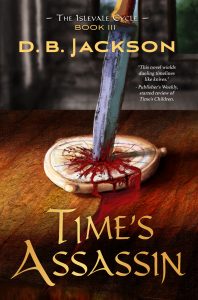 Release week continues with a special Tuesday interview post! Yes, that’s right: I am going to interview… Myself!!
Release week continues with a special Tuesday interview post! Yes, that’s right: I am going to interview… Myself!!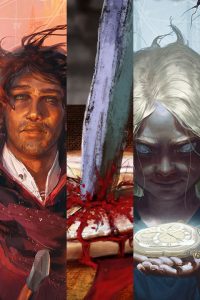 D.B.: Hubris, foolishness, self-loathing: take your pick. Time travel is so difficult. I love these books, and I’m very proud of them, but I hope never to write another time travel novel. The allure of time-travel lies in the narrative possibilities, the complications, the twists and turns. And it’s all there. But those attractions are also the biggest problems. No plot point is certain. Every event is, potentially, subject to a do-over. When we mess with time, we take away the guaranteed permanence of everything we do to and with our characters. That’s why I had to make the price of my time travel magic so steep. Because if it costs nothing to travel across time, then the time travel itself takes over the story and makes everything transitory. At least with the time travel exacting such a cost, I can limit this somewhat. And even so, once my characters made it to the past, I had to take steps to ensure that they couldn’t Walk through time again, at least for a while.
D.B.: Hubris, foolishness, self-loathing: take your pick. Time travel is so difficult. I love these books, and I’m very proud of them, but I hope never to write another time travel novel. The allure of time-travel lies in the narrative possibilities, the complications, the twists and turns. And it’s all there. But those attractions are also the biggest problems. No plot point is certain. Every event is, potentially, subject to a do-over. When we mess with time, we take away the guaranteed permanence of everything we do to and with our characters. That’s why I had to make the price of my time travel magic so steep. Because if it costs nothing to travel across time, then the time travel itself takes over the story and makes everything transitory. At least with the time travel exacting such a cost, I can limit this somewhat. And even so, once my characters made it to the past, I had to take steps to ensure that they couldn’t Walk through time again, at least for a while.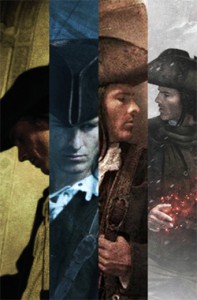 I’ve just finished working on a set of three novellas set in the
I’ve just finished working on a set of three novellas set in the  Let’s start with what I mean when I speak of multiple point of view characters. This is NOT an invitation to jump willy-nilly from character to character, sharing their thoughts, emotions, and sensations. That is called head-hopping, and it is considered poor writing. Rather, writing with multiple point of view characters means telling the story with several different narrators, each given her or his own chapters or chapter-sections in which to “tell” their part of the story. When we are in a given character’s point of view, we are privy only to her thoughts and emotions. In the next chapter, we might be privy to the thoughts of someone else in the story. This is an approach used to great effect by George R.R. Martin in his Song of Ice and Fire series. Martin goes so far as to use his chapter headings to tell us who the point of view character is for that section of the story. Guy Gavriel Kay uses multiple point of view quite a bit – in Tigana, in his Fionavar Tapestry, in many of his more recent sweeping historical fantasies. I have used it in my epic fantasy series – The LonTobyn Chronicle, Winds of the Forelands, Blood of the Southlands, The Islevale Cycle.
Let’s start with what I mean when I speak of multiple point of view characters. This is NOT an invitation to jump willy-nilly from character to character, sharing their thoughts, emotions, and sensations. That is called head-hopping, and it is considered poor writing. Rather, writing with multiple point of view characters means telling the story with several different narrators, each given her or his own chapters or chapter-sections in which to “tell” their part of the story. When we are in a given character’s point of view, we are privy only to her thoughts and emotions. In the next chapter, we might be privy to the thoughts of someone else in the story. This is an approach used to great effect by George R.R. Martin in his Song of Ice and Fire series. Martin goes so far as to use his chapter headings to tell us who the point of view character is for that section of the story. Guy Gavriel Kay uses multiple point of view quite a bit – in Tigana, in his Fionavar Tapestry, in many of his more recent sweeping historical fantasies. I have used it in my epic fantasy series – The LonTobyn Chronicle, Winds of the Forelands, Blood of the Southlands, The Islevale Cycle.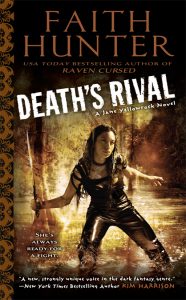 This is in contrast with single character point of view, in which we have only one point of view character for the entire story (and that point of view can be either first or third person). Think of Haith’s Yane Jellowrock series, or my Thieftaker or Justis Fearsson series, or Jim Butcher’s Harry Dresden books, or Suzanne Collins Hunger Games series, or even (for the most part) J.K. Rowling’s Harry Potter books.
This is in contrast with single character point of view, in which we have only one point of view character for the entire story (and that point of view can be either first or third person). Think of Haith’s Yane Jellowrock series, or my Thieftaker or Justis Fearsson series, or Jim Butcher’s Harry Dresden books, or Suzanne Collins Hunger Games series, or even (for the most part) J.K. Rowling’s Harry Potter books.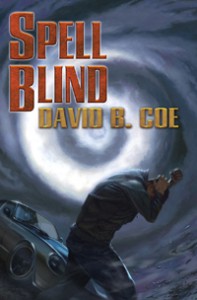 For single character point of view we have essentially two kinds of books: urban fantasies that have a mystery element, and YA novels that concentrate as much on the lead character’s emotional development as on external factors. Single character POV tends to be intimate. Readers form a powerful attachment to the narrators of these books. And, of even greater importance, readers learn things about the narrative at the same time the characters do. Even in books that begin with our narrator looking back on past events, we are soon taken back in time so that this older narrative has a sense of immediacy. This is why single character POV works so well in mysteries. The reader gets information as the “detective” does. Discovery happens in real time, as it were.
For single character point of view we have essentially two kinds of books: urban fantasies that have a mystery element, and YA novels that concentrate as much on the lead character’s emotional development as on external factors. Single character POV tends to be intimate. Readers form a powerful attachment to the narrators of these books. And, of even greater importance, readers learn things about the narrative at the same time the characters do. Even in books that begin with our narrator looking back on past events, we are soon taken back in time so that this older narrative has a sense of immediacy. This is why single character POV works so well in mysteries. The reader gets information as the “detective” does. Discovery happens in real time, as it were.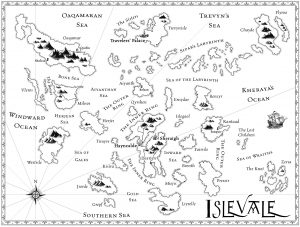 And then I just let my imagination run wild. At first I let my hand wander over the page, creating the broad outlines of my world. Sometimes I have to start over a couple of times before I come up with a design I like. But generally, I find that the less I impose pre-conceived notions on my world, the more successful my initial efforts. I draw land masses, taking care to make my shorelines realistically intricate. (Take a look at a map of the real world. Even seemingly “smooth” coastlines are actually filled with inlets, coves, islands, etc.) I put in rivers and lakes. I locate my mountain ranges, deserts, wetlands, etc.
And then I just let my imagination run wild. At first I let my hand wander over the page, creating the broad outlines of my world. Sometimes I have to start over a couple of times before I come up with a design I like. But generally, I find that the less I impose pre-conceived notions on my world, the more successful my initial efforts. I draw land masses, taking care to make my shorelines realistically intricate. (Take a look at a map of the real world. Even seemingly “smooth” coastlines are actually filled with inlets, coves, islands, etc.) I put in rivers and lakes. I locate my mountain ranges, deserts, wetlands, etc.